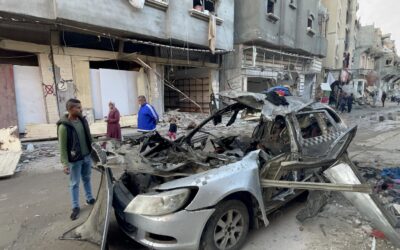
The Case For Investing in Wartime Ukraine
SUBSCRIBER+EXCLUSIVE INTERVIEW — While Ukraine deals with shortages of troops, munitions, and equipment for its air defenses, some Ukrainians are teaming up with foreign investors […] More
Ambassador Joseph DeTrani is former Special envoy for Six Party Talks with North Korea and the U.S. Representative to the Korea Energy Development Organization (KEDO), as well as former CIA director of East Asia Operations. He later served as the Associate Director of National Intelligence and Mission Manager for North Korea and the Director of the National Counter Proliferation Center, while also serving as a Special Adviser to the Director of National Intelligence.
OPINION — On June 16, 2020, North Korea announced that they demolished the Joint Liaison Office with South Korea, located in Kaesong, North Korea. This development shouldn’t come as too much of a surprise, since Kim Yo-jong, the sister of Chairman Kim Jung-un announced last week that North Korea was ceasing all dialogue with the South and would abolish the Joint Liaison Office, noting that she was deferring to the North Korean military. Kim Yo-jong said that this was in response to the propaganda balloons being sent into North Korea from those North Korean defectors now living in South Korea. She said North Korea was holding South Korea and the government of Moon Jae-in responsible for these provocative acts from the South.
The balloons are, in my view, a cover for North Korea’s overall unhappiness with South Korea. The failure of the Hanoi Summit in February 2019 between President Donald Trump and Chairman Kim Jung-un, when the North apparently expected the U.S. to agree to the lifting of sanctions for a halt to activities at Yongbyon, is an event that obviously continues to anger Kim Jung-un. Thus South Korea’s continued inability to get some form of sanctions relief for the North, either by pressuring the U.S. to lift some sanctions or to defy the U.S. and independently provide some relief, like with the resumption of South Korean visits to Mount Kumgang, or reuniting separated families from the Korean War or reopening sections of the Kaesong Industrial Park, and presenting it as a humanitarian gesture due to the Covid-19 pandemic, probably motivated Kim Jung-un to make the decision to cease all contact with the South. The symbolism and economic value of the Kaesong Industrial Park, established in 2003 with over 120 factories and 50,000 North Korean workers, supported by managers and investment from the South, should not be underestimated. This was a major initiative between the two Koreas and the economic value to the North was significant. So, from North Korea’s perspective, South Korea couldn’t or wouldn’t produce, which angered Kim Jung-un and probably motivated him to designate his sister, Kim Yo-jong, as the new senior official responsible for relations with the South. And Kim Yo-jong’s message is clear: South Korea is weak and can’t be trusted.
The symbolism of demolishing the Joint Liaison Office also happened on the 20th anniversary of the June 15, 2000 Peace Summit between Kim Jong-il, the father of Kim Jung-un, and Kim Dae-jung, the leader of South Korea. This Peace Summit ended with a declaration that both leaders would bring peace and reconciliation to the Korean Peninsula. In fact, Kim Dae-Jung received the Nobel Peace prize for this peace summit.
Given these events, and the vitriol from Kim Yo-jong, the sister and likely heir apparent to Kim Jung-un, it’s possible the North will reintroduce the North Korean military into those sections of the DMZ that were demilitarized in 2018 – after President Moon Jae-in and Chairman Kim Jung-un, in April of 2018, signed the Panmunjom Declaration, committing both sides to peace, prosperity and reconciliation on the Korean Peninsula.
The situation on the Korean Peninsula is tense and the North, unhappy with the U.S., is holding the South responsible for not doing more to provide some sanctions relief, especially at a time when there’s considerable malnourishment and possibly some starvation in the North, likely exacerbated by cases of Covid-19, despite the North’s protestations that they have no cases of Covid-19.
It’s likely North Korea will continue to put pressure on South Korea and escalate tension with the U.S., with additional missile launches and the threat of another nuclear test, expecting the U.S. and South Korea eventually to relent and provide North Korea with some form of sanctions relief or a promise of relief if the North agreed to resume negotiations with the U.S. This has been the North’s playbook: When unhappy, escalate tension and the U.S. and South Korea eventually will accommodate.
This column by Cipher Brief Expert Ambassador Joseph DeTrani was first published in The Washington Times.
Read more expert-driven national security insight, perspective and analysis in The Cipher Brief
Related Articles

SUBSCRIBER+EXCLUSIVE INTERVIEW — While Ukraine deals with shortages of troops, munitions, and equipment for its air defenses, some Ukrainians are teaming up with foreign investors […] More

SUBSCRIBER+EXCLUSIVE INTERVIEW — With a mere 1.2 million citizens, Estonia is among NATO’s smallest members, but its contributions to Ukraine have led the pack by […] More

SUBSCRIBER+EXCLUSIVE BRIEFING — Drone weapons are part of the daily narrative of the war in Ukraine – from Russia’s use of Iranian drones against infrastructure […] More

SUBSCRIBER+ EXCLUSIVE ANALYSIS — Iran’s retaliatory strikes against Israel this weekend were both a potentially game-changing, historic first — and an underwhelming response. Historic, because […] More

SUBSCRIBER+EXCLUSIVE INTERVIEW — Ukraine was hit by a fresh round of Russian missile attacks on Thursday, strikes that targeted and damaged the country’s power grid […] More

SUBSCRIBER+ EXCLUSIVE REPORTING — The Israeli drone strike that killed three adult sons (who Israel says were Hamas operatives) and four grandchildren of Hamas’s Qatar-based […] More
Search